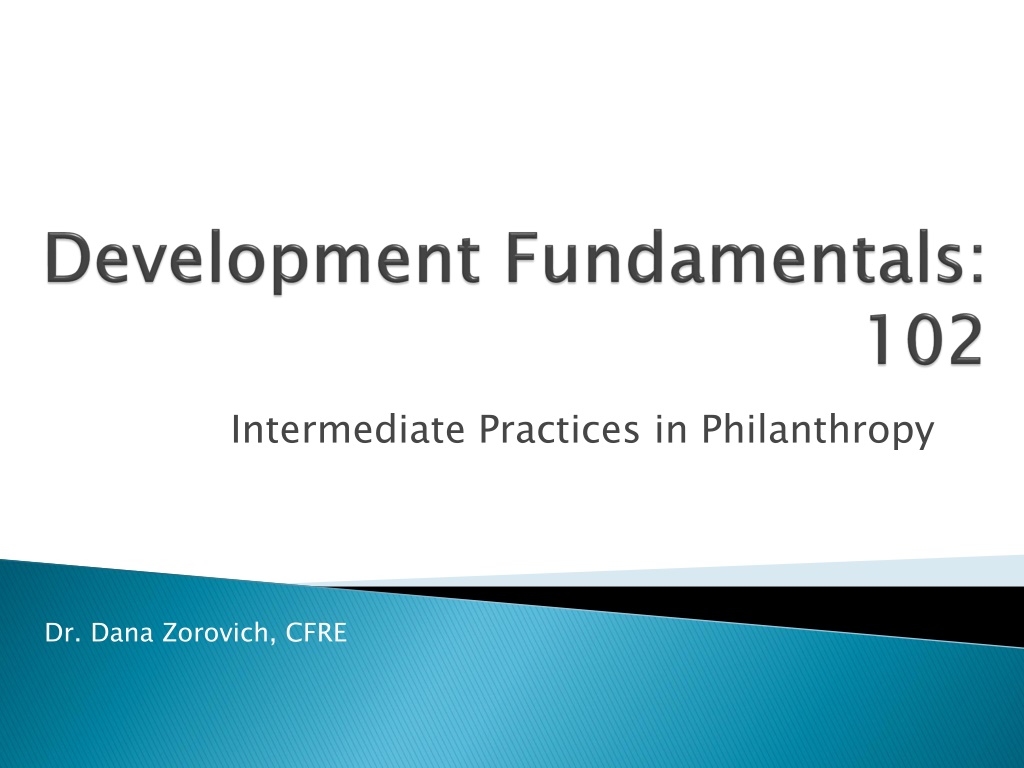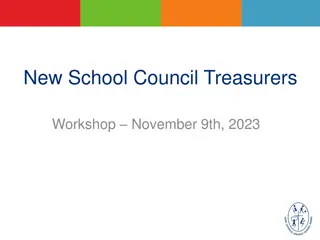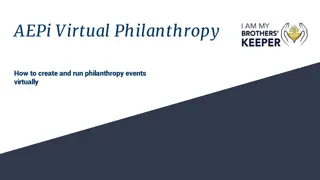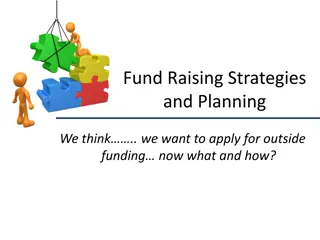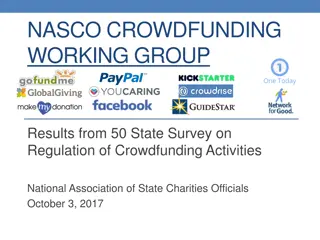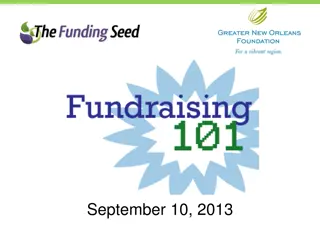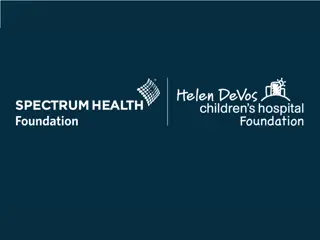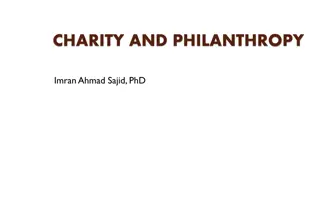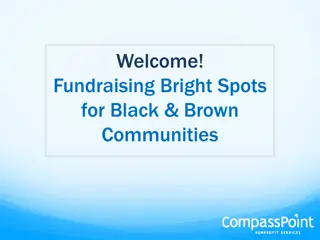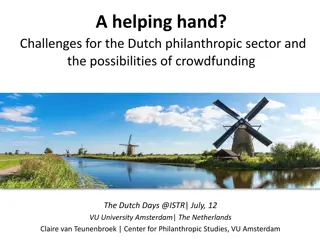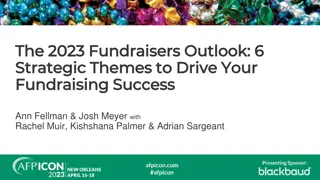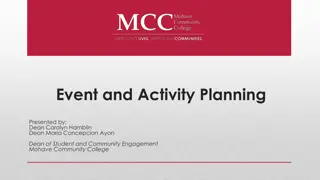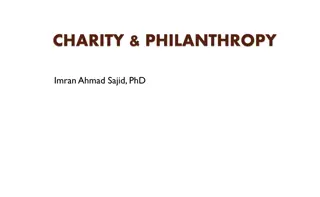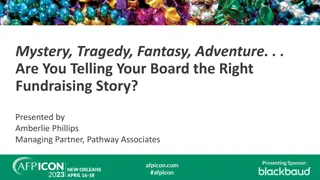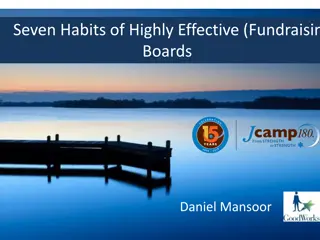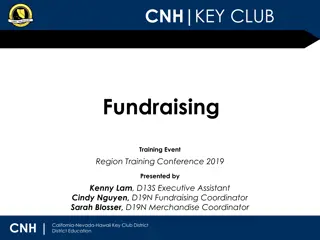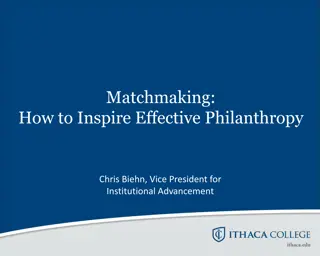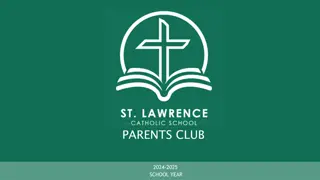Advanced Practices in Philanthropy and Fundraising Strategy
Explore the advanced practices in philanthropy and fundraising strategy, covering prospecting, cultivation, solicitation, relationship building, volunteer management, data management, gathering, analysis, donor survey components, and more. Learn how to effectively identify prospects, prioritize solicitations, conduct prospect research, and qualify donors to enhance fundraising efforts.
Download Presentation

Please find below an Image/Link to download the presentation.
The content on the website is provided AS IS for your information and personal use only. It may not be sold, licensed, or shared on other websites without obtaining consent from the author. Download presentation by click this link. If you encounter any issues during the download, it is possible that the publisher has removed the file from their server.
E N D
Presentation Transcript
Intermediate Practices in Philanthropy Dr. Dana Zorovich, CFRE
The College Board is driven by a single goal to ensure that every student has the opportunity to prepare for, enroll in and graduate from college. Our work falls broadly into three categories: College Readiness, College Connection and Success, and Advocacy. 2
As a not-for-profit membership association representing more than 5,900 colleges, universities and schools, the College Board leads national and international efforts to improve access to and readiness for higher education. As Federal and State funds are declining, the College Board is responding to a need voiced by our constituents for tools and practices to attract private foundations to your college readiness efforts. 3
philanthropy, n. the common good. Acknowledgement: Philanthropy is a private sector means of effecting social change outside of government. It is an acknowledgement that Government cannot resolve all societal issues and acts as an outlet for those voluntarily seeking change. philanthropy, n. a voluntary act for
Prospecting Cultivation and Solicitation Relationship Building Volunteer Management Fundraising Management Accountability
Data Management Tools to identify individuals and groups Segmentation Delineation between suspects and prospects Categorize by potential (rating) Prioritize and plan solicitations Ambassador training System to store information Retrieval and analysis cycles Leading training efforts Prospect Research Plan Solicitations
Data Gathering and Analysis Prospect Information Sources Written/Published Materials People The Internet
Qualifying Prospects Donor Survey Components and Use Market Survey Components and Use Prospect Screening, Qualifying, and Rating
Giving Capacity Code 1 Giving Capacity Code Giving Potential Giving Potential Giving Inclination Code 1 Giving Inclination Code Description Description $500,000 + Clearly turned off; no record of interest Minimal interest, occasional donor, attends meetings, infrequently Moderately active or formally very active Very active, regular donor, committee member Governing Board member, regular gift, very engaged 2 $100,000-$499,999 2 3 $50,000-$499,999 3 4 $10,000-$49,999 4 5 Under $10,000 5
Annual Giving Major Gifts Planned Gifts
External Testing/Evaluation Secure gifts Internal Survey/study response to materials Design solicitation materials Comprehensive Campaign Plan Training to increase effectiveness Case for Support Assessment
Planned gifts Major gifts Annual gifts Volunteerism Which gifts are from your pocketbook, checkbook, or portfolio?
Giving Pyramid Giving Pyramid Ultimate Gift Bequest Planned Gifts Investment Special Gifts Involvement Endowment Campaigns Capital/Special Campaigns Annual Campaigns Renewal First Time Gift Interest Awareness Information Special Events Public Relations Identification Publications
case, n. the reasons why an organization both needs and merits philanthropic support, usually by outlining the organization s programs, currents needs, and plans. Source: AFP, Fundraising Dictionary
The Case Statement Will: The Case Statement Will: 1. Identify and validate the needs 2. Document the needs 3. Identify programs and strategies designed to meet the needs 4. Establish the competence of the organization and its staff 5. Explain who will benefit from the services that will be made possible with a gift
Relationship Management Prospect Management Negotiation Techniques
Present the Case Overcome Objections Opening Involvement Close
Investment Involvement Interest
Fundraising Intervention Transactional Short-tern oriented Get the money and get out Centered on organization Linear thinking Not fulfilling Dominated by networks Fundraising Philanthropy Interaction Transformational Long-term oriented Get the person Donor centered System thinking Totally satisfying Driven by mission/vision Philanthropy
Identification Screening Response/Recognition Solicitation Introduction Rating Interest Involvement Appreciation
Identification and Recruitment Replacement Training Representation and Responsiveness Recognition Maximize Commitment though Meaning
Leadership Support Volunteer Fundraising Professional Services Field Support
Alignment with Philanthropy Short and Long Term Plans and Budgets Strategic Planning Performance Analysis Effectiveness of Program Effectiveness of Staff Legal and Ethical Standards Policy Governance
The responsibility, duty, and obligation of the board of directors working in concert with senior administrative staff, to successful manage the organization's programs and services and to steward all its fiscal activities. Duty of Care Duty of Loyalty Duty of Obedience
Reporting Audiences Public Trust Compliance Transparency Allocations are appropriate Financial records IRS rules Legal considerations, e.g., planned giving Donors Board Staff
I. the way the organization intends to use donated resources, and of its capacity to use donations effectively for their intended purposes. II. on the organization's governing board, and to expect the board to exercise prudent judgment in its stewardship responsibilities. III. recent financial statements. IV. purposes for which they were given. I. To be informed of the organization's mission, of II. To be informed of the identity of those serving III. To have access to the organization's most IV. To be assured their gifts will be used for the 26
V. VI. handled with respect and with confidentiality to the extent provided by law. VII. organizations of interest to the donor will be professional in nature. VIII. volunteers, employees of the organization or hired solicitors. IX. mailing lists that an organization may intend to share. X. receive prompt, truthful and forthright answers. Developed By American Association of Fund Raising Counsel (AAFRC) Association for Healthcare Philanthropy (AHP) Council for Advancement and Support of Education (CASE) Association of Fundraising Professionals (AFP) V. To receive appropriate acknowledgment and recognition. VI. To be assured that information about their donations is VII. To expect that all relationships with individuals representing VIII. To be informed whether those seeking donations are IX. To have the opportunity for their names to be deleted from X. To feel free to ask questions when making a donation and to Developed By 27
Prospecting Cultivation and Solicitation Relationship Building Volunteer Management Fundraising Management Accountability
Catherine Dunn cdunn@collegeboard.org Catherine Dunn cdunn@collegeboard.org
